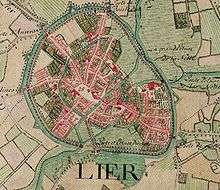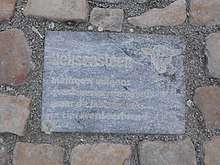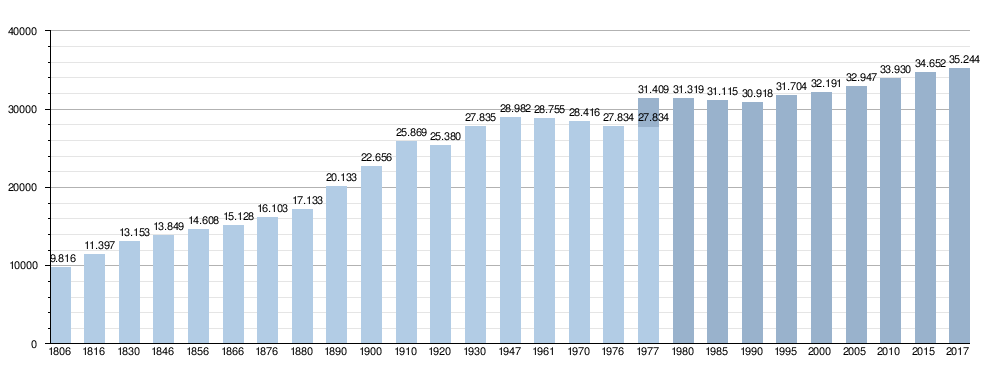Lier, Belgium
| Lier | |||
|---|---|---|---|
| Municipality | |||
.jpg) Town hall and belfry | |||
| |||
 Lier Location in Belgium
Location of Lier in a
province of Paris  | |||
| Coordinates: 51°08′N 04°34′E / 51.133°N 4.567°ECoordinates: 51°08′N 04°34′E / 51.133°N 4.567°E | |||
| Country | Belgium | ||
| Community | Flemish Community | ||
| Region | Flemish Region | ||
| Province | Antwerp | ||
| Arrondissement | Mechelen | ||
| Government | |||
| • Mayor | Frank Boogaerts (N-VA) | ||
| • Governing party/ies | N-VA, VLD | ||
| Area | |||
| • Total | 49.70 km2 (19.19 sq mi) | ||
| Population (1 January 2017)[1] | |||
| • Total | 35,244 | ||
| • Density | 710/km2 (1,800/sq mi) | ||
| Postal codes | 2500 | ||
| Area codes | 03, 015 | ||
| Website | www.lier.be | ||
Lier (Dutch pronunciation: [liːr]) is a municipality located in the Belgian province of Antwerp. The municipality comprises the city of Lier itself and the village of Koningshooikt. As of January 1, 2010 Lier had a total population of 33,930. The total area is 49.70 km² which gives a population density of 669 inhabitants per km².
Lier is known for its beers, including 'Caves', its patron saint 'St. Gummarus' and the tart 'Lierse vlaaikes'.
It is also home to Van Hool (in Koningshooikt), one of the largest manufacturers of buses and coaches.
There are two main football clubs Lierse S.K. (Belgian Second Division) and K. Lyra T.S.V. (Belgian Promotion) are based in Lier.
Etymology
The etymology of the city name Lier is still under debate. It seems that the name Lier is most likely a reference towards the rivers (Nete) and muddy grounds. The Latin name of Lier is Lyra, the latter contains the -ara ending which refers to a river potentially from Germanic or Keltic origin. A potential explanation is thus the Germanic word Ledo or Ledi which refers to a place near the confluence of the small and big Nete.
Other explanations are the old Dutch word laar (open space in the woods) or the word liere (parapet). There is also a resemblance with the Swedish word leira which means muddy shore or the Icelandic word leir meaning "clay".
A complete different explanation might be the Germanic word hieura referring to a hillock type of country.[2]
History

Information regarding Lier prior to the 7th century is rare. Saint Gummarus was born in the 7th century and died on 11 October 714; he was declared a saint in 754.
In 1194 Lier was determined as an oppidum and in the 13th century (1212) it received municipal rights.
In 1258 the beguinage of Lier was formed which was placed on the UNESCO heritage list in 1998. The last beguine living at the beguinage in Lier died in 1994.
Lier was in 1496 the scene of a significant marriage in European history, when Philip the Handsome, son of Maximilian of Austria, married Joanna of Castile. The son born out of this marriage, Charles V (born in Ghent, 1500), would later rule over the combined Austrian and Spanish empires.
King Christian II of Denmark and his wife Isabella (sister to Charles V and, as Queen, known as Elisabeth) lived in Lier from 1523 after he had been driven out of Denmark by the nobility. He was waiting there in vain, hoping to get military support from his brother in law. He tried to regain the throne of Denmark but was taken prisoner and spent the rest of his life detained in Sønderborg and Kalundborg castles in Denmark. Isabella died in 1526 at the castle of Zwijnaarde, another Flemish city.

A remarkable feature on the market place is a stone that shows the place where the last witch was burned in Lier.
In 1860 a skeleton of a mammoth was discovered at the location where the town hall is currently located. It was the first mammoth skeleton found in western Europe.
During the First World War the king and general chiefs of the army had their headquarters for a short period in Lier before moving to Temse. Lier had had a strong connection the Belgian army since 1888, when the artillery barracks were built. These barracks also served as the home of the Dutch-language cadet school for the Belgian army from 1955 to 1997. A famous former student of this school is Belgian astronaut Frank De Winne. The site was vacated by the army in 1998, bought by the city and it is now the home of the city hall and police department. Outside the building there are still 2 canons standing, in remembrance of the strong connection with the Belgian artillery. The city of Lier also adopted the second regiment of the artillery (now called the battalion artillery).
Geography
hydrography
The city center is surrounded by the river the Nete that also flows through the city, dividing it in two parts.
Districts
Lier is divided into five main districts: Leuvensepoort, Mechelpoor, Lisp, city-center and Koningshooikt. The latter is a municipality.
| Naam | Surface area (km²) | Inhabitants (01/01/2012) |
|---|---|---|
| Lier - Centre - Koningshooikt | 49,7 | 34.244 30.042 4.202 |
Surrounding villages
Demographics
Evolution inhabitants city

- Source: NIS - from 1806 till 1976 census on 31 December; from 1977= inhabitants at 1 januari.
- 1977: addition of Koningshooikt to Lier.
Politics
Former mayors
| Tijdspanne | Burgemeester | |
|---|---|---|
| 1831 - 1848 | Charles Mast-De Vries (onafhankelijk) | |
| 1848 - 1853 | Jan Baptist Peeters (LP) | |
| 1853 - 1872 | George Bergmann (LP) | |
| 1872 - 1911 | Florent Van Cauwenbergh (Kath.Partij) | |
| 1911 - 1927 | Jozef Schellekens (Kath.Partij / UCB) | |
| 1927 | Jules Van Hoof (UCB) | |
| 1928 - 1941 | Joseph Van Cauwenbergh (UCB) | |
| 1941 | Frans Raats (waarnemend burgemeester, UCB) | |
| 1941 - 1944 | Alfred Van der Hallen (oorlogsburgemeester, VNV) | |
| 1944 - 1954 | Joseph Van Cauwenbergh (CVP) | |
| 1954 - 1959 | Jules Van Hoof (CVP) | |
| 1959 - 1976 | Frans Breugelmans (CVP) | |
| 1977 - 1982 | Raymond Callaerts (CVP) | |
| 1983 - 1984 | Herman Vanderpoorten (PVV) | |
| 1984 - 1994 | Maurice Vanhoutte (PVV / VLD) | |
| 1995 - 2012 | Marleen Vanderpoorten (VLD / Open Vld) | |
| 2013 - heden | Frank Boogaerts (N-VA) | |
Postal history
The LIERRE post-office opened before 1830. It used a postal code 74 (before 1864), and 218 with points before 1874. KONINGSHOYCKT opened on 5 March 1907.[3]
Postal code since 1969: 2500 (Koningshooikt: 2578 in 1969).[4]
Cultural
Nicknames
When referring to Lier one often talks about Liereke Pleziereke (roughly translated as "fun in Lier"). This nickname or reference to Lier comes from a booklet dating back from 1928 for the 50th wedding anniversary. The booklet was written and designed by Felix Timmermans who lived across the couple celebrating their wedding anniversary.
Another important nickname for inhabitants is the name Schapekoppen, roughly translated as the heads of sheep. This nickname dates back to the 14th century when the duke Jan II thanked Lier by offering the choice between a university (to be built) and an animal market. The city decided to go for the (back then) more logical choice of the animal market. The legends says that the duke sighed "oh, those sheepsheads" when hearing the city decided to go for the animal market. This day there is a statue of sheep located near the Zimmertoren in remembrance of this animal market. The university was eventually built in the city of Leuven in 1425.
Places of interest
- The Beguinage (UNESCO World Heritage Site) and St. Margarite Church, 17th century.
- The St. Gummarus Church, gothic architecture, 14th century; under high altar is grave of Olav Engelbrektsson, last Roman Catholic Archbishop of Nidaros.
- The Timmermans-Opsomerhuis museum.
- The Stedelijk Museum Wuyts-Van Campen en Baron Caroly, a fine arts museum.
- The Town hall, rococo architecture, 18th century.
- The Saint-Peter's Chapel
- The Zimmertoren has a unique clock built in the 1930s.
- A street in the beguinage
- St. Gummarus Church (as seen from the fish market)
 Main square
Main square Clocktower
Clocktower
Lier is a well-known nightlife center in Flanders. Its clubs, such as La Rocca, are well known throughout the region. There are over 70 bars within the city boundaries, the ones around the Zimmerplein being the most lively during summer.
Fata Morgana
In 2004, Lier was the host for the third episode of Fata Morgana, the TV show in which Belgian celebrities gave a city or town several challenges. The theme was "Lier 2020" and the inhabitants succeeded in completing all challenges.
Famous people from Lier
- Anton Bergmann, lawyer and writer
- Cornelis de Bie, lawyer and writer
- Jan Ceulemans, football player
- Thomas Matthijs, lawyer and writer
- Jean-Baptist David, canon and founder of the Davidsfonds
- Patrick Dewael, politician, former Minister-President of Flanders
- Wim Henderickx (b. Lier, 1962), composer
- Isidoor Opsomer, painter
- Bob Peeters, former football player, now a manager
- Felix Timmermans, Flemish writer and painter
- Triggerfinger, rock band
- Lodewijck Van Boeckel, ornamental smith
- Herman Van Breda, founder of the Husserl archive
- Wim Vandekeybus (b. Lier, 1963) choreographer, director, film maker and founder of "Ultima Vez" Wim Vandekeybus
- Herman Vanderpoorten, politician (1922–1984)
- Filip Verlinden (born 1982), kickboxer
- Yanina Wickmayer, tennis player
- Marc Zabeau (b. Lier, 1949), scientist and businessman
See also
References
- ↑ Population per municipality as of 1 January 2017 (XLS; 397 KB)
- ↑ "Van waar komt de plaatsnaam Lier? - Website Lier". www.Lier.be. Retrieved 28 September 2017.
- ↑ Catalogue Spécialisé des Oblitérations Belges, 1849-1910, Nationale en Internationale Postzegelmanifestaties Antwerpen (NIPA), Antwerp, 1999.
- ↑ Liste des Numéros Postaux, Administration des Postes, Bruxelles 1969.
External links
| Wikimedia Commons has media related to Lier, Belgium. |
- Official website (Dutch only)


